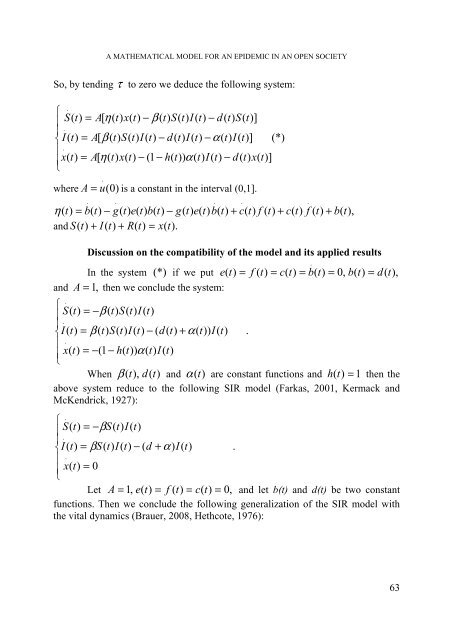biologia - Studia
biologia - Studia
biologia - Studia
You also want an ePaper? Increase the reach of your titles
YUMPU automatically turns print PDFs into web optimized ePapers that Google loves.
A MATHEMATICAL MODEL FOR AN EPIDEMIC IN AN OPEN SOCIETY<br />
So, by tending τ to zero we deduce the following system:<br />
.<br />
⎧<br />
⎪<br />
S(<br />
t)<br />
= A[<br />
η(<br />
t)<br />
x(<br />
t)<br />
− β ( t)<br />
S(<br />
t)<br />
I(<br />
t)<br />
− d(<br />
t)<br />
S(<br />
t)]<br />
.<br />
⎨I(<br />
t)<br />
= A[<br />
β ( t)<br />
S(<br />
t)<br />
I(<br />
t)<br />
− d(<br />
t)<br />
I(<br />
t)<br />
−α(<br />
t)<br />
I(<br />
t)]<br />
(*)<br />
.<br />
⎪<br />
⎪x(<br />
t)<br />
= A[<br />
η(<br />
t)<br />
x(<br />
t)<br />
− (1 − h(<br />
t))<br />
α(<br />
t)<br />
I(<br />
t)<br />
− d(<br />
t)<br />
x(<br />
t)]<br />
⎩<br />
.<br />
where A = u(0)<br />
is a constant in the interval (0,1].<br />
.<br />
.<br />
η ( t ) = b(<br />
t)<br />
− g(<br />
t)<br />
e(<br />
t)<br />
b(<br />
t)<br />
− g(<br />
t)<br />
e(<br />
t)<br />
b(<br />
t)<br />
+ c(<br />
t)<br />
f ( t)<br />
+ c(<br />
t)<br />
f ( t)<br />
+ b(<br />
t),<br />
and S ( t)<br />
+ I(<br />
t)<br />
+ R(<br />
t)<br />
= x(<br />
t).<br />
.<br />
Discussion on the compatibility of the model and its applied results<br />
In the system (*) if we put e ( t)<br />
= f ( t)<br />
= c(<br />
t)<br />
= b(<br />
t)<br />
= 0, b(<br />
t)<br />
= d(<br />
t),<br />
and A = 1,<br />
then we conclude the system:<br />
.<br />
⎧<br />
⎪<br />
S(<br />
t)<br />
= −β<br />
( t)<br />
S(<br />
t)<br />
I(<br />
t)<br />
.<br />
⎨I(<br />
t)<br />
= β ( t)<br />
S(<br />
t)<br />
I(<br />
t)<br />
− ( d(<br />
t)<br />
+ α(<br />
t))<br />
I(<br />
t)<br />
.<br />
.<br />
⎪<br />
⎪ x(<br />
t)<br />
= −(1<br />
− h(<br />
t))<br />
α(<br />
t)<br />
I(<br />
t)<br />
⎩<br />
When β ( t),<br />
d(<br />
t)<br />
and α (t)<br />
are constant functions and h ( t)<br />
= 1 then the<br />
above system reduce to the following SIR model (Farkas, 2001, Kermack and<br />
McKendrick, 1927):<br />
.<br />
⎧<br />
⎪<br />
S(<br />
t)<br />
= −βS(<br />
t)<br />
I(<br />
t)<br />
.<br />
⎨I(<br />
t)<br />
= βS(<br />
t)<br />
I(<br />
t)<br />
− ( d + α)<br />
I(<br />
t)<br />
.<br />
.<br />
⎪<br />
⎪ x(<br />
t)<br />
= 0<br />
⎩<br />
Let A = 1 , e(<br />
t)<br />
= f ( t)<br />
= c(<br />
t)<br />
= 0,<br />
and let b(t) and d(t) be two constant<br />
functions. Then we conclude the following generalization of the SIR model with<br />
the vital dynamics (Brauer, 2008, Hethcote, 1976):<br />
.<br />
.<br />
.<br />
63
















